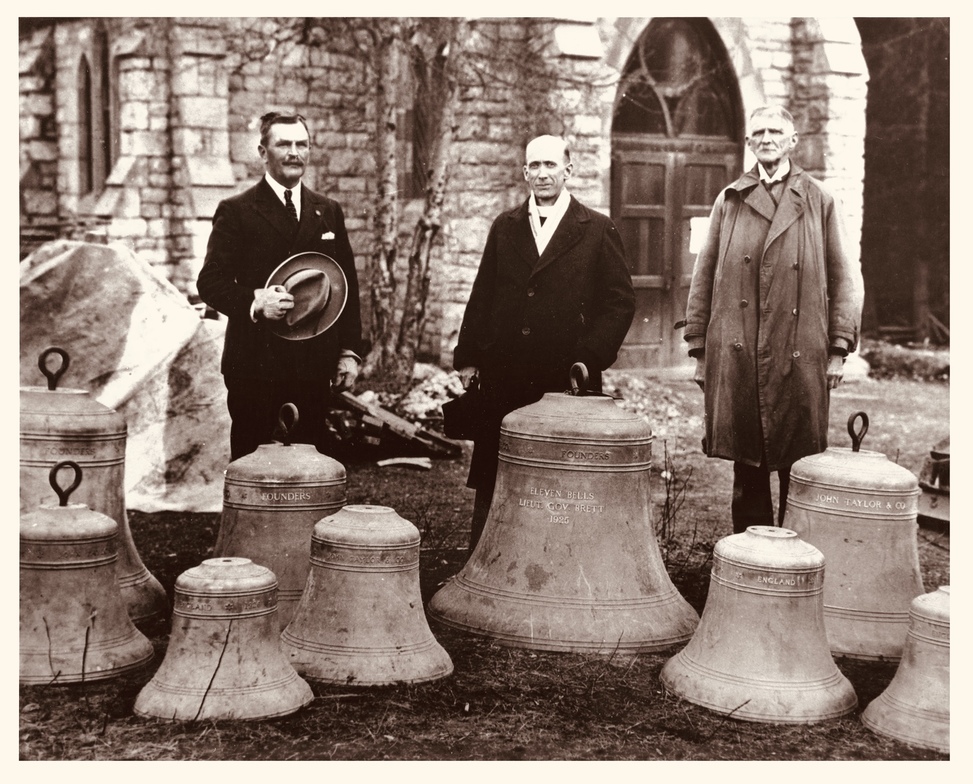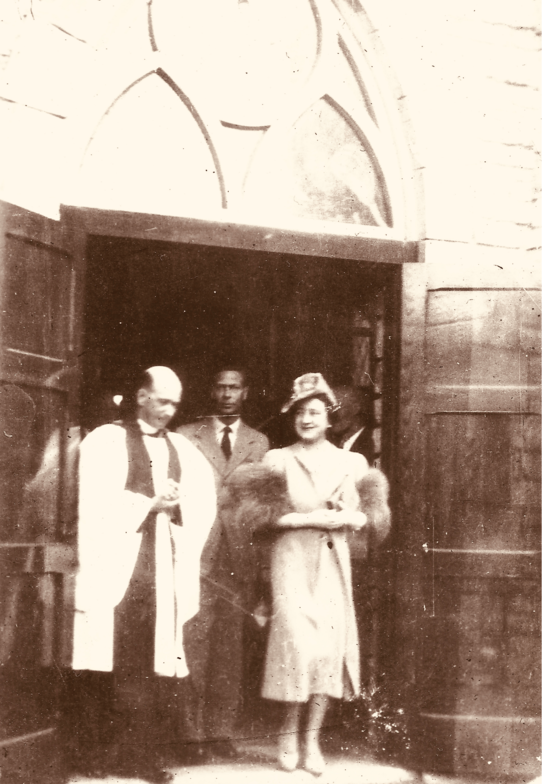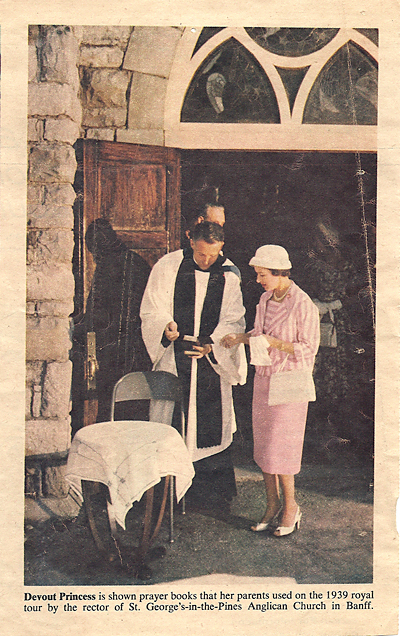The story of St. George’s-in-the-Pines begins with the birth of Banff itself. As the Canadian Pacific Railway carried visitors into the Rockies, small groups gathered for Anglican worship in a log cabin on Bear Street in 1887. The congregation longed for a permanent place of worship that would match the beauty of its setting.
On October 21, 1889, Lady Stanley, wife of the Governor General, laid the cornerstone for a new stone church. The site chosen was the highest point in the village, a location that would make the little church visible from all sides. Building was slow, and money was scarce, but the people were determined. The chancel was finished first in 1897, and for years parishioners met under tents in summer while waiting for the nave to be completed. At last, in 1902, the first bays of the nave rose in local Rundle stone, giving Banff a church as sturdy and enduring as the mountain ridges around it.
If the cornerstone gave St. George’s its foundation, the tower and bells gave it its voice. The dream was realized through the leadership and generosity of Dr. Robert George Brett, one of Banff’s most important civic figures and later the Lieutenant Governor of Alberta, together with the determined fundraising of parishioners and townsfolk.
In the summer of 1926, a spectacular fair was held at Bretton Hall, complete with music, food, and games, to raise money for the project. That event, remembered as one of Banff’s grandest social occasions, brought together residents, visitors, and businesses to make the vision possible. With the funds secured, construction of the tower began soon after. Built of Rundle rock quarried along the Spray River, the tower rose forty feet, and its spire was said to harmonize with the pointed slopes of Mount Rundle.
In 1927 the tower was crowned with a remarkable set of eleven bells, cast by John Taylor & Co. of Loughborough, England, one of the world’s oldest bell foundries. These were stationary bells, played not by swinging ropes but from a wooden clavier inside the tower.
On summer evenings and feast days, visitors gathered outside to hear the bells ring hymns and national songs. Canon Tully Montgomery, who became rector in 1924 and remained for over thirty years, was himself often at the clavier. His lively playing made the bells a beloved feature of the Banff soundscape. The singing tower became, and remains, the most distinctive feature of St. George’s identity.

St. George’s has always been closely tied to the life of the nation. In 1901, during their tour of Canada, the Duke and Duchess of Cornwall and York, who later became King George V and Queen Mary, attended morning service here while visiting Banff.
Even more famously, on Whitsunday, May 29, 1939, King George VI and Queen Elizabeth worshipped at St. George’s during their historic pre-war tour across Canada. The royal family’s attendance was a proud moment for the parish and for the whole town. A special pew was reserved and marked with a brass plaque that can still be seen today. After the service, Their Majesties presented the parish with a set of silver candlesticks, still used on the altar for great festivals and royal occasions.
In later decades, the Archbishop of Canterbury, Geoffrey Fisher, visited in 1954, as did other bishops from across the Anglican Communion. These visits reminded the parish that although nestled in the Rockies, it stood in fellowship with the wider church around the world.
Canon Henry Tully Montgomery, rector from 1924 until his death in 1955, shepherded the church through its greatest era of growth. It was during his ministry that the tower and bells were completed, the stained glass program began, and the parish became firmly established as Banff’s Anglican landmark. Known for his pastoral warmth and his love of music, Montgomery embodied the gracious hospitality for which St. George’s is still known. His long service gave continuity to a parish that welcomed visitors from every corner of the world.
For many visitors, the most striking feature of St. George’s is its stained glass. Each window tells a story of faith while also reflecting the Banff landscape.
The first major installation was in 1920: the St. George window in memory of Sid Unwin, a beloved mountain guide killed in the First World War. Created by Robert McCausland Ltd. of Toronto, it depicts St. George in vivid colour and set the tone for the church’s future memorials.
In the 1920s, five chancel windows were dedicated, bathing the sanctuary in jewel tones. They depict the Baptism of Christ, the Nativity, the Crucifixion, Easter morning at the tomb, and the disciples’ encounter with Jesus on the road to Emmaus. These traditional themes anchored the east end of the church in the central story of Christianity.
In 1959, artist Jessie van Brunt created the Bell Ringers window, a cascade of angels making music in honour of the tower chimes. In 1964 “The Light of the World” was installed in the nave, inspired by the famous pre-Raphaelite painting, reminding worshippers that Christ is present at the door of every heart.
The 1969 Brewster memorial window wove Banff’s natural world into sacred art. It features Rocky Mountain wildlife, including moose and big-horn sheep, along with Mount Brewster itself, linking creation and Creator in one luminous design.
The crowning additions came in 1979. The Crosby memorial window was installed in the west wall above the doors. This large rectangular window portrays Lake Louise, Mount Victoria, and lodgepole pine branches, blending the Christian story with the grandeur of the Rockies. That same year the circular Theotokos, or Mother of God, window was placed above the doors, completing the west end with an image of Mary and the Christ Child.
Together, these windows make St. George’s a jewel box of light. They weave together scripture, memorials, and the Rocky Mountains themselves, drawing visitors into worship and wonder.
After Montgomery’s time, the parish turned to practical needs. A new parish hall was built across the street in the late 1950s and opened in 1962. St. George’s Hall quickly became a hub for church and community gatherings: Sunday school classes, teas, bazaars, concerts, and countless celebrations. The debt was paid off within a few years, and parishioners marked the occasion with a jubilant mortgage burning. The hall remains an important part of parish life, extending the mission of the church beyond its stone walls.
In the late twentieth century, St. George’s continued its tradition of welcome. The parish joined other Bow Valley churches in sponsoring Vietnamese families fleeing war, helping them settle into Banff life and even celebrating a memorable triple wedding in 1981.
In 1989, St. George’s marked its centennial with thanksgiving services, concerts, and the publication of a parish history written by local historian Jon Whyte. The centennial year brought together parishioners, townspeople, and visitors in celebration of a hundred years of worship in the Rockies.
St. George’s-in-the-Pines continues to stand as a living witness to more than a century of faith in Banff. From the laying of its cornerstone in 1889 to the ringing of its bells, from stained glass windows that catch the Rocky Mountain light to silver candlesticks given by a king and queen, it is a place where beauty, history, and worship meet.
Today the church is led by Rev. Seth Enriquez, Rector. St. George’s is committed to sharing the love of God found in Jesus Christ through Banff Food & Friends, which provides nearly 300 free meals every Monday, through regular Bible studies, a philosophy club for children, and through the heart of parish life, Sunday worship at 10:00 a.m.
Visitors are warmly invited to join us. Whether you come as a parishioner, a pilgrim, or a passerby, you are part of the ongoing story of St. George’s, a sanctuary for travellers and a neighbour to its town.


.png)


.png)
